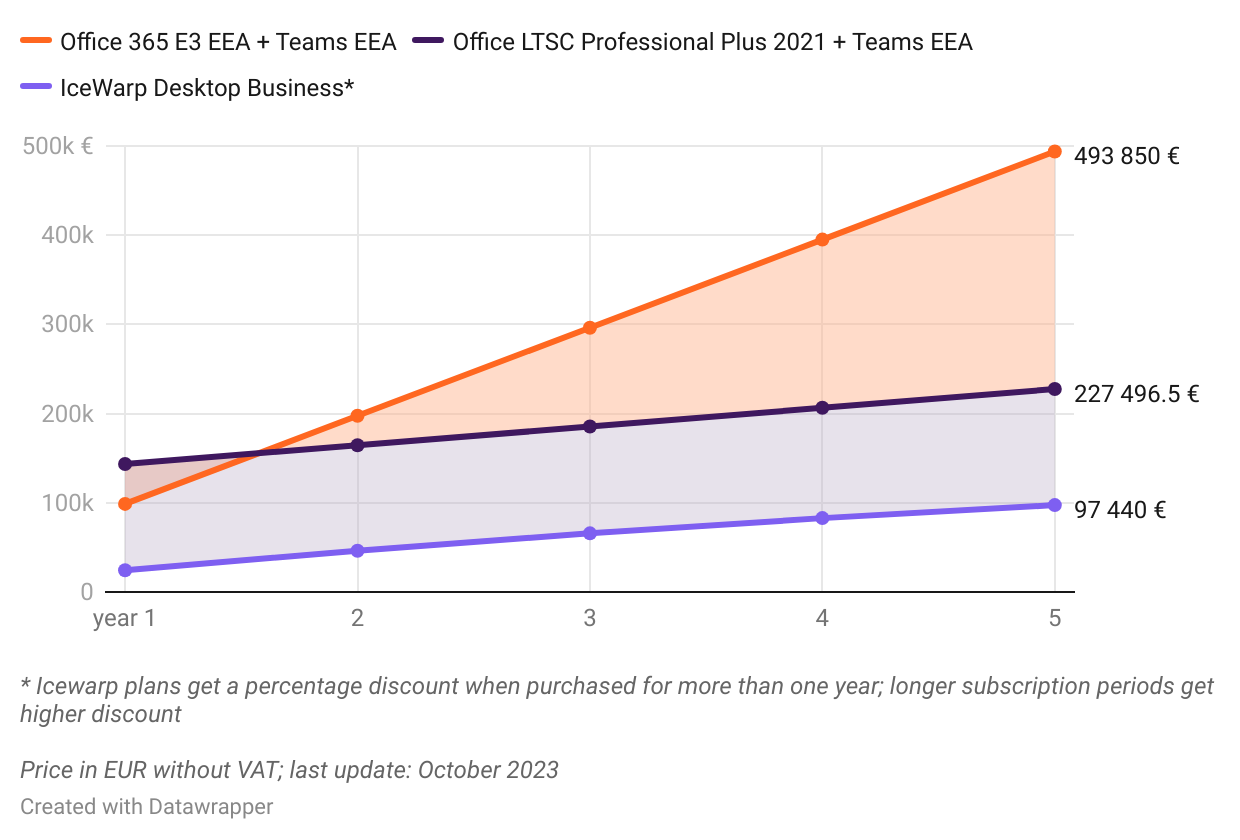As of October 2023, Microsoft is removing Teams from their Enterprise suites for the EEA and Switzerland¹. The affected subscription plans, such as Office 365 E1/E3/E5 and Microsoft 365 E3/E5, will no longer include the popular collaboration service – it will be available for purchase only as a separate product.
The split is a result of the European Union’s continuous efforts to have a fair market with fewer monopolies. It’s been deemed that Microsoft is getting an unfair edge over their competitors by bundling Teams with its business-oriented subscription plans² – this meant that other solutions were automatically excluded, even though they could provide equally suitable services for communication and collaboration.
As a result of the current change, organisations with more than 300 employees (the common Enterprise suite users) who have been relying on the popular tool will have to rethink their IT infrastructure, workflows, and budget. For Office 365 E1 and E3 subscribers, it won’t even be the first time this year, as Microsoft increased these plans’ prices of their cloud services in April.
What are your options now?
Firstly, if your company is already subscribed to Microsoft 365 Enterprise or Business services, it can continue using these cloud suites as they are, no changes required. The new rules mostly concern new subscribers.
Next is assessing whether your organisation really needs Microsoft 365 tools and features, and especially Teams (which won’t be included in the new EEA-specific plans). Our Product Manager Mateusz Drozdowski offers expert insight on the topic:
“Business is never one-size-fits-all, and the same goes for software solutions. In large enterprises, it’s often beneficial to combine various licensing models to achieve the most cost-efficient setup. For instance, you could deploy perpetual Microsoft Office licenses along with Teams for your regular employees, and opt for the more feature-rich Office 365 E3 (also supplemented by Teams) for the management tier.
But why rely on Microsoft at all? The key is to align your software strategy with your operational needs, not with the needs of the software manufacturer. There are different alternatives, such as IceWarp, that provide equally robust services, yet at a much lower price.”
“Business is never one-size-fits-all, and the same goes for software solutions. In large enterprises, it’s often beneficial to combine various licensing models to achieve the most cost-efficient setup. For instance, you could deploy perpetual Microsoft Office licenses along with Teams for your regular employees, and opt for the more feature-rich Office 365 E3 (also supplemented by Teams) for the management tier.
But why rely on Microsoft at all? The key is to align your software strategy with your operational needs, not with the needs of the software manufacturer. There are different alternatives, such as IceWarp, that provide equally robust services, yet at a much lower price.”

Product Manager
To give you a concrete example, let’s analyse 3 possible scenarios for a hypothetical company with 350 employees that would like to purchase a new Office 365 E3 subscription plan:
- Subscription-only solution: Microsoft Office 365 E3 EEA + Microsoft Teams EEA – likely the least optimised choice but if Microsoft 365 functionalities are absolutely crucial for the company’s processes, for example if it’s heavily dependent on Azure service, it might be the only option. However we highly recommend conducting an in-depth analysis in such cases to make sure unnecessary costs are avoided.
- Hybrid solution: Used Microsoft Office LTSC Professional Plus 2021 + Microsoft Teams EEA – if the company needs Microsoft 365 plans mainly to use standard Office programs (Word, Excel, Outlook etc) and Teams, this new change can be great for it, because most of the annual costly service can be replaced with a one-time payment for used Office LTSC Professional Plus 2021 while subscribing to Teams EEA separately.
- Alternative solution: IceWarp Desktop Business – the company can decide to opt out of the Microsoft ecosystem entirely and go for a different platform, such as IceWarp Desktop Business. It is accessible both on the cloud and on local devices, and includes apps and services equivalent to those of Office 365 E3 (Word, Excel, PowerPoint, Outlook, OneNote, Exchange, SharePoint, OneDrive).
IceWarp is a Microsoft 365 alternative which offers similar apps, tools, features, and even UI, comes at a significantly lower price (at least 2 times cheaper on average), and includes the possibility of easy migration from Microsoft services, assisted by the IceWarp support staff.
Price comparison: A company with 350 employees over a period of 5 years
Hover over the graph for additional data.
As is immediately apparent, IceWarp, the alternative service solution, is significantly more cost-friendly from the get-go than a Microsoft 365 subscription and is more than 5 times cheaper by year 5; the hybrid solution becomes cheaper after just one year.
Conclusion
Due to its prolonged and widespread presence on the software market, Microsoft has a strong leverage on companies’ software-related decisions. Additionally, the SaaS licensing model continues to concentrate even more power into the megacorporation’s hands. It is imperative for businesses to start exploring alternatives more thoroughly instead of letting habit and familiarity guide them, shoul d they want to reduce their operational costs as well as be less reliant on Microsoft’s views on the future of software. Don't let the sudden changes in Microsoft's pricing and licensing structure derail your plans, IT infrastructure, operational efficiency, or budget!
Our licensing consultants are well-equipped to help you find the most cost-optimised solution tailored to your business needs. Contact us for a free consultation and licensing advice.
¹ Microsoft’s official announcement: https://www.microsoft.com/en-us/licensing/news/Microsoft365-Teams-EEA
² The European Commission's press release: https://ec.europa.eu/commission/presscorner/detail/en/ip_23_3991

